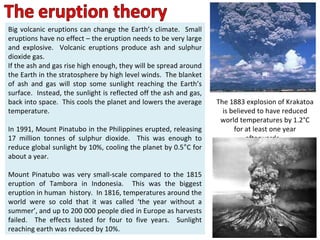
The natural causes of climate change
- 1. Big volcanic eruptions can change the Earth’s climate. Small eruptions have no effect – the eruption needs to be very large and explosive. Volcanic eruptions produce ash and sulphur dioxide gas. If the ash and gas rise high enough, they will be spread around the Earth in the stratosphere by high level winds. The blanket of ash and gas will stop some sunlight reaching the Earth’s surface. Instead, the sunlight is reflected off the ash and gas, back into space. This cools the planet and lowers the average temperature. In 1991, Mount Pinatubo in the Philippines erupted, releasing 17 million tonnes of sulphur dioxide. This was enough to reduce global sunlight by 10%, cooling the planet by 0.5 ° C for about a year. Mount Pinatubo was very small-scale compared to the 1815 eruption of Tambora in Indonesia. This was the biggest eruption in human history. In 1816, temperatures around the world were so cold that it was called ‘the year without a summer’, and up to 200 000 people died in Europe as harvests failed. The effects lasted for four to five years. Sunlight reaching earth was reduced by 10%. The 1883 explosion of Krakatoa is believed to have reduced world temperatures by 1.2°C for at least one year afterwards.
- 2. The Sun’s output is not constant. Cycles have been detected that reduce or increase the amount of solar energy. Over 2000 years ago Chinese astronomers started to record sunspots. These are black areas on the surface of the sun. Sometimes the sun has lots of these spots. At other times they disappear. Even though the spots are dark, they tell us that the sun is more active than usual. Lots of spots mean more solar energy being fired out from the sun towards Earth. Cooler periods, such as the Little Ice Age, and warmer periods, such as the Medieval Warm Period, may have been caused by changes in sunspot activity. Some people think that, on average, there were more volcanic eruptions during the Little Ice Age, and that this added to the cooling. However, climate change on timescales of a few hundred years, and 1-2°C, cannot be explained by volcanoes – but it might be explained by sunspot cycles. Temperatures are greatest when there are plenty of sunspots – because it means other areas of the Sun are working even harder!
- 4. The natural causes of climate change Long term changes (may last for many centuries) Short term changes (lasting just a few years) The orbital theory The sunspot theory The eruption theory